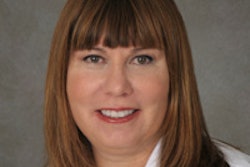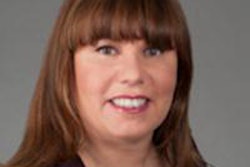
Some recent articles have suggested the existence of a gender gap in pay for radiologists. In my experience, I've never made as much as my male colleagues -- and that's OK with me. Why? Let me tell you a story of not so long ago ...
I did not make partner in my radiology group, and I was crushed. Not long out of training, I called a meeting of the board -- the group elite -- to argue that the only reason I did not make partner was because I was female. The tribunal of elders was intimidating: gray hair, white coats, stern faces. Looking back, I can't believe I had the nerve.
Why did the august partners deem I was not really partnership material, while the three men who started with me were? Maybe they were right and I did not have the right stuff. But really?
 Dr. Mary Morrison Saltz.
Dr. Mary Morrison Saltz.Did they want someone to do procedures? Wait a minute, I was an interventional radiologist.
Was my work quality bad? No, it wasn't that. My training must have been lacking. But wait, I came from Massachusetts General Hospital.
I know -- it was perhaps because I made a stink when the chief of surgery put his hand under my blouse and began to caress the skin of my waist in the reading room. But actually, I never mentioned that to anyone. I didn't want to create a problem for referrals, so I smiled sweetly and just quietly redirected his hand.
Perhaps the local referring docs didn't think highly of me, or maybe they just didn't like me. Yet I was the only member of our group to be invited to join the premier local medical social society -- an honor, and a great opportunity to share cutting-edge practices and to curry favor with the local referral base.
So, no, I could not figure out why they didn't want me to become a partner. Yet I heard that our hospital radiology chief was unhappy with me because -- as he said -- "She is a girl." This, the same man who was rumored to routinely sneak his hand under the tech's aprons during fluoroscopy, did not want me to join the family of partners. But he did want me to stay on, work for less, and be paid a salary. After all, I had a husband to support me.
My work was good enough to represent the group. Yet did the guys want me to invade the partnership meetings? Equal pay for equal work? Not happening. The fraternal ties of brotherhood were sacred and not to be broken. Entering the sacrosanct chamber of the group meeting, where the decisions were made and the key interpersonal bonds that allowed the group to function in harmony were formed, was not for a girl.
When confronted, they said, "We need a bit longer to evaluate the quality of your work, and while we can't actually criticize your performance so far, we still need more information to make our decision. We can't tell yet if you are good enough for partnership."
Somehow, they had no trouble evaluating the guys, yea or nay. The only woman they had previously hired, amazingly enough, did not make partner and left before I arrived.
So their decision was to keep me on salary for another year, and then wait and see. I took the offer and met the challenge. Not easy, because I felt that every time I went to the bathroom, I got a demerit.
A year of purgatory followed -- and then victorious partnership! I had gone from hospital to hospital for a year, scrutinized by all, under a lens, examined and judged, and finally was deemed worthy.
Just the beginning
Yet this happy ending was just the beginning of the story. The very essence of partnership is a group of equals working for the common good. The very best radiology groups are better than the sum of their parts, with each radiologist giving his or her very best effort all the time, striving for the common good.
Those who can speak well are the face of the group, putting in long hours at meetings and spreading good will beyond the immediate confines of the practice. The docs with "good hands" are busy working interventional miracles, and the lightning-fast imagers plow through the high relative value unit (RVU) images at what seems like the speed of light. The best chiefs are those who recognize and exploit the talents of the group members and help each to do his or her best for the common good.
Any radiologist perceived as not giving as much as the others to the common good creates friction and discontent. Women have two battles to fight: one is perception, and the other is reality. We can be perceived as being structurally less able to contribute to the common good, especially if we have children.
This was perhaps my initial problem. As soon as I got pregnant, I was viewed as less able to contribute and my chance at partnership was jeopardized. Young women just starting their careers may be vulnerable to fewer opportunities because they are perceived as a risk to the group.
Yet my group members were able to see beyond their initial point of view. Their willingness to allow me to be a full partner and still work part time was unprecedented and, I felt, an honor. This unusual flexibility allowed me to achieve equal pay for equal work! By the time I had my second child, it was hard for me to keep up with the pace of private practice.
Our chief recognized that flexibility could help make the whole group stronger and allow each member to give his or her best effort. The group collectively decided that I could pay a partner to cover my evening and weekend shifts (he later suggested naming his boat the "Mary Claire" after me; he was able to finance it through all the shifts I gave him). I was still responsible for finding coverage and for doing the shift myself if I could not find help.
That meant I did my share of holidays and weekends, but I did not shoulder the whole burden. I made equal pay for equal work, maintained a full partner's vote, served as a hospital chief, and sat on the group's leadership team, but in actuality I did not really work full time.
And while I made equal pay for equal work, I made less than my partners. Why? Because I worked less! So unless we are willing to actually do the same amount of work, we will make less than our male counterparts. Is that fair? I think so. What do you think?
Dr. Mary Morrison Saltz is a board-certified diagnostic radiologist. She is currently CEO of Imagine Image Innovation, a company that uses big data to improve delivery of radiology services.
Most recently, she served as chief medical officer for Hospital Radiology Partners. She has served as radiology chair and service chief at hospitals in Florida, Ohio, and at Emory Johns Creek Hospital in Johns Creek, GA. Dr. Saltz is a member of the American College of Physician Executives, the American College of Radiology, and the Radiological Society of North America, and she sits on the Citizens Advisory Council of the Duke Cancer Institute in Durham, NC.
A hands-on leader, Dr. Saltz's expertise is working hand-in-hand with hospital administration to guide radiology teams to success. Dr. Saltz has led quality assurance programs in Florida and Ohio, and she served as chief quality officer for community practice initiatives at Emory Health Care. She also has more than 20 years of private-practice experience.
She is a graduate of McGill University, with a Bachelor of Science in Human Genetics, and Duke University, where she obtained her Doctor of Medicine. Her postgraduate education included a residency at Boston University where she served as chief resident, and a fellowship in interventional abdominal radiology at Massachusetts General Hospital.
The comments and observations expressed herein do not necessarily reflect the opinions of AuntMinnie.com.



















